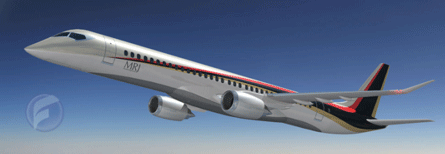Mitsubishi Aircraft has introduced a stretched variant to its MRJ regional jet family and unveiled extensive design changes, including using aluminium instead of carbonfibre composites for the aircraft's wings.
The changes are being made after discussions with potential customers in Europe and the USA, and the final design will now be frozen in mid-2010 instead of the third-quarter of 2009.
As a result, the first flight is delayed from the fourth quarter of 2011 to the second quarter of 2012. Launch customer All Nippon Airways will receive its first aircraft in the first quarter of 2014 instead of the fourth quarter of 2013.

"Although first flight is delayed by two quarters, the number of flight test aircraft will be increased from four to five, which will shorten the flight test period," says Mitsubishi Aircraft. The changes are necessary to ensure that the company comes up with a competitive regional jet, it adds.
Mitsubishi could add a 100-seat model to the already announced 92-seat MRJ90 and 78-seat MRJ70, potentially putting it in contention against Bombardier's CRJ1000 and Embraer's E190.
"The MRJ stretch model is added to the family to respond to customer needs. The launch is subject to demand and business case," it says.
With the aluminium wings, the company moves away from its earlier aim of using significant amounts of composite materials for the airframe. The result is that the only remaining composite parts will be the empennage, horizontal tail and vertical tail, amounting to 10-15% of the total airframe.
"Conceptually, this is a very big change," admits Mitsubishi Aircraft. "Structural changes are easier and require shorter lead-time with aluminium wings. With an aluminium wing box, the wing structure can be more easily optimised for the MRJ70/90 and the stretch model, which enhances the overall competitiveness of the MRJ family."
The change will allow its engineers to develop an optimum wing for the MRJ90 and minimise the deterioration of range performance for the stretched version. The biggest benefit will be for the MRJ70, which will weigh less.
"This will allow weight reduction through structural changes, allowing for larger winglets and resulting in a reduction of block fuel [consumption] and take-off performance improvement," says Mitsubishi.
The company has also increased the height of the cabin by 1.5in (3.81cm) to 80.5in, increasing the fuselage height by 2.5in to 116.5in. This will give the MRJ a rounder cabin, and one that is wider and higher than comparable aircraft manufactured by Bombardier and Embraer.
The aft cargo compartment has been enlarged and the forward cargo compartment is eliminated. This will make "baggage handling simpler and easier and to use space more efficiently", says Mitsubishi.
It reiterates that the changes will not affect the performance of the MRJ, promising that this will still be "the most fuel efficient aircraft, have the lowest fuel-burn, noise and emissions, and the most comfortable cabin" in the regional jet market.
"We want to deliver an aircraft that our customers will want and use for decades," says Mitsubishi.
Source: Flight Daily News



















